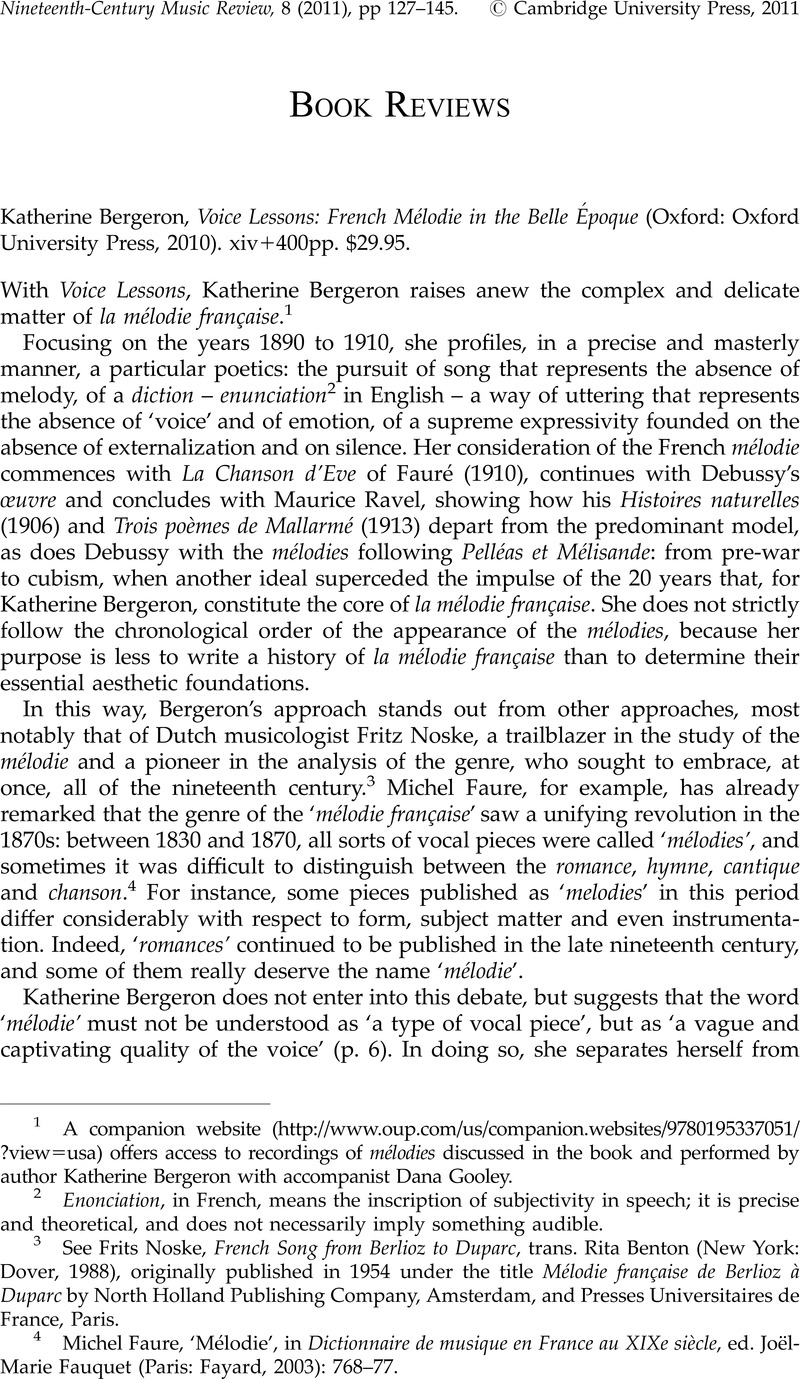No CrossRef data available.
Article contents
Katherine Bergeron, Voice Lessons: French Mélodie in the Belle Époque (Oxford: Oxford University Press, 2010). xiv+400pp. $29.95.
Review products
Published online by Cambridge University Press: 27 June 2011
Abstract

- Type
- Book Review
- Information
- Nineteenth-Century Music Review , Volume 8 , Issue 1: Music in Nineteenth-Century Greece , 27 June 2011 , pp. 127 - 133
- Copyright
- Copyright © Cambridge University Press 2011
References
1 A companion website (http://www.oup.com/us/companion.websites/9780195337051/?view=usa) offers access to recordings of mélodies discussed in the book and performed by author Katherine Bergeron with accompanist Dana Gooley.
2 Enonciation, in French, means the inscription of subjectivity in speech; it is precise and theoretical, and does not necessarily imply something audible.
3 See Noske, Frits, French Song from Berlioz to Duparc, trans. Rita Benton (New York: Dover, 1988)Google Scholar, originally published in 1954 under the title Mélodie française de Berlioz à Duparc by North Holland Publishing Company, Amsterdam, and Presses Universitaires de France, Paris.
4 Faure, Michel, ‘Mélodie’, in Dictionnaire de musique en France au XIXe siècle, ed. Joël-Marie Fauquet (Paris: Fayard, 2003): 768–777Google Scholar.
5 Johnson, Graham, A French Song Companion (Oxford: Oxford University Press, 2000): 34–36Google Scholar.
6 Faure, Michel and Vivès, Vincent, Histoire et poétique de la mélodie française (Paris: Centre national de la recherche scientifique [CNRS], 2000)Google Scholar.
7 Unpublished letter to Jacques Durand, 12 Mar. 1913, cited by Jean-Michel Nectoux in Camille Saint-Saëns et Gabriel Fauré, Correspondance, 1862–1920, 3rd ed. (Paris: Klincksieck, 1994): 26.
8 Unpublished letter to Charles Lecocq, ibid.
9 The term ‘hussards noirs’ refers to the cadre of public school instructors of the Third République, formed following the 1905 Law on the Separation of Church and State, which established secularism as a fundamental civil principle in France, and alludes to fifteenth-century Hungarian cavalrymen known for their devotion as well as their severity. The notion reflects a militant, anticlerical secularity, advocating the French Republic (revolutionary and Jacobin) over tenacious regionalism.
10 Carlo Caballero devotes the first chapter of Fauré and French Musical Aesthetics (Cambridge: Cambridge University Press, 2001) to the role of sincérité in that composer's art; see 1–56. Quoted by Bergeron on p. 54.
11 Nectoux, Jean-Michel, Gabriel Fauré: Les Voix du clair-obscur (Paris: Fayard, 2008): 568Google Scholar: ‘cette utilisation discrète d'un motif cyclique rapproche Mirages des cinq “vénitiennes”, de trente années antérieures’.
12 Le Chant du Monde Records, LDC 278 895/96, CM 202.
13 d'Indy, Vincent, Cours de composition, vol. 1 (Paris: Durand et fils, 1903): 29–46Google Scholar, and Appendice, ‘Notions générales sur la Prosodie dans la musique vocale’: 355–9.


